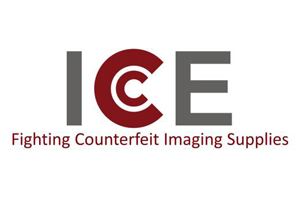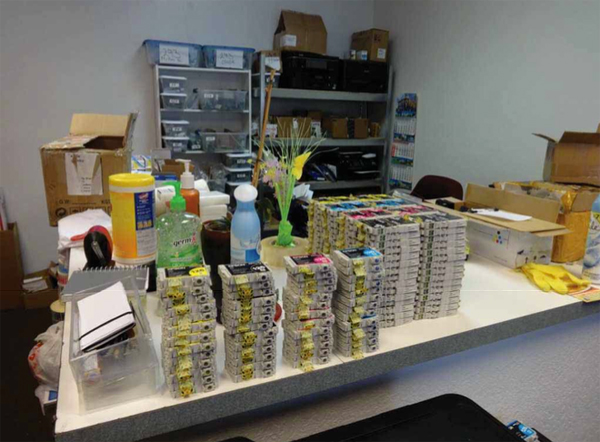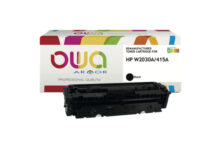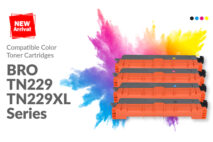 For more than a decade, a growing number of cheap ink and toner cartridges based on patent-infringing technologies have been polluting printing supplies markets around the world. Because such cartridges are frequently sold using deceptive marketing claims, the surging availability of infringing cartridges has meant big trouble for the legitimate supplies industry. Infringing cartridges, which are often referred to as “clones” or “imitations,” have been gaining market share for years, leaving companies that produce non-infringing consumables and their channel partners to cope with relentless pricing pressures and margin compression.
For more than a decade, a growing number of cheap ink and toner cartridges based on patent-infringing technologies have been polluting printing supplies markets around the world. Because such cartridges are frequently sold using deceptive marketing claims, the surging availability of infringing cartridges has meant big trouble for the legitimate supplies industry. Infringing cartridges, which are often referred to as “clones” or “imitations,” have been gaining market share for years, leaving companies that produce non-infringing consumables and their channel partners to cope with relentless pricing pressures and margin compression.
There are costs associated with producing non-infringing cartridges. These supplies include genuine cartridges from original equipment manufacturers (OEMs) and cartridges from third-party manufacturers, including remanufacturers and companies that produce reverse-engineered compatible cartridges. Each year, OEMs invest billions of dollars to develop cartridges that work flawlessly within their printing platforms. Most remanufactured cartridges, which are empty cores that are refurbished and refilled with ink or toner, are produced using processes that do not violate any intellectual property (IP) and with components that are pricey but perform well. Similarly, a small group of technically-savvy manufacturers have developed workarounds for various patents and bring to market their own high-quality non-infringing compatibles.
In contrast, the cost of bringing ink and toner clones to market is minimal because they are simply copied. Typically produced in regions were IP protections are not enforced, these so-called imitations are sold at artificially low price points that undercut the price of non-infringing consumables. Clones do not require the research and development investments made by OEMs and third-party compatible makers or the costs remanufacturers must pay to collect and store empties. In order to keep prices dirt cheap, clones are often made in factories where poorly-paid workers endure abysmal conditions using inferior raw materials and components. Of course, the resulting products perform terribly.
Regardless, because they are sold at prices that are only a fraction of the legitimate equivalent products, infringing products appear to be irresistible to a growing number of firms. Each year, businesses around the world turn a blind eye to what are obviously unrealistically low prices and opt to purchase the bogus products over non-infringing cartridges. Some fall prey to false claims made by unscrupulous vendors. And many, many end users are victimized as low-quality imitation cartridges continue to proliferate.
An Unflattering History
Cheap, infringing ink and toner cartridges have been around forever, but in the past decade or so we have watched the availability skyrocket. Shipments grew during the Great Recession as end users in homes and businesses alike looked to save money whenever and wherever they could. As economies worsened and the situation for many grew increasingly desperate, more customers were willing to risk buying clones despite the fact that prices were suspiciously low.
Although the recession was initially a boon to the remanufacturing industry, market conditions took a surprisingly ugly turn. Remanufactured cartridges sell at a discount of between 15 and 25 percent compared to the equivalent OEM product. Thus, as was the case in past recessions, remanufacturers benefited when the economy tanked late in 2007 and orders surged during 2008.
But as the recession deepened things did not unfold as remanufacturers had expected. Unemployment rates soared past levels previously experienced and printing volumes at most businesses plunged, thus generating fewer empty cartridges. The supply of empties quickly dwindled and became expensive—if they could be purchased at all. Lacking the most essential raw material, cheap empties, the price of remanufactured cartridges rose and the availability declined. Third-party supplies vendors faced spot shortages and higher price points, which could not be passed along to extremely price-sensitive consumers. Over time, rather than sell remans, a growing number of vendors turned to overseas factories for inexpensive, newly manufactured non-OEM cartridges. Unfortunately, a significant portion of these imports were infringing imitations and the clone industry thrived as its products gobbled up the remanufacturing industry’s market share.
Coincidental to the swelling demand for infringing cartridges was the rise of ecommerce. During the years prior to the recession, thousands of websites had sprung up and Internet-based merchants were selling a lot of ink and toner cartridges. Staples.com, for example, emerged as one of largest websites in terms of revenue thanks largely to all the digital imaging supplies it sold. Of course, few sites had the scale and resources of a Staples.com, and many smaller sites were willing to sell products from sources that might not be rigorously vetted. With its lax IP protections and low level of accountability, the Internet became the perfect home for the clone.
When economies improved and people got back to work and started printing, the popularity of clones did not abate. And the popularity continues.
Recent Deceptions
Of course, compared to legitimate supplies, the popularity of clones is limited to a small segment of the market. Many consumers who have purchased cheap cartridges online have regretted it. The low rankings given cheap infringing ink and toner cartridges on sites like Amazon tell the tale. Reading reviews of products like $8 toner cartridges, it is not at all uncommon to learn about clones that leak, or print poorly, or never worked at all. But clones are also frequently used in bait-and-switch scams by deceptive telemarketers and by other unscrupulous hucksters, so consumers may be tricked into purchasing an infringing product.
In a rather extreme case filed in October 2018, the United States Attorney’s Office for the Eastern District of California brought eight counts of wire fraud and mail fraud against Jim Meron, the operator of two office-supplies distributors, WOW Imaging Products and Time Enterprises. The defendant was accused of bilking U.S. federal agencies out of as much as $3.5 million by marketing low-priced OEM cartridges on a couple of U.S. government procurement platforms. When filling orders, Mr. Meron delivered cheap non-OEM cartridges and pocketed the difference. Upon pleading guilty to wire fraud, Mr. Meron was ordered to repay more than $1.72 million. At the time of this writing, he was awaiting sentencing and faced jail time that could run up to 20 years.
While counterfeiting is rare in the United States these days, it does happen. Epson is currently pursuing legal actions against various companies and individuals in courts in California and Nevada. The Nevada case stems from raids conducted in 2016 by U.S. Marshals, with the assistance of Epson, on a counterfeiting ring that resulted in the seizure of tens of thousands of counterfeit Epson inkjet cartridges and the equipment and materials needed to make thousands more. The California case centers on a complex network of Amazon sellers purveying bogus Epson inkjet cartridges. Defendants in the matter in Nevada face a $12 million default judgment, which they are appealing, while the case in California is in its initial phases.
Clones Cost Billions
Counterfeiting is a criminal enterprise and, because it’s so lucrative, it attracts drug cartels, terrorist organizations, and other nefarious groups. While the intent of individuals and companies involved in cloning ink and toner cartridges may not be as sinister as those of the counterfeiters, the infringing products that clone-makers bring to market are arguably more dangerous, especially to any business that must compete with them.
Non-OEM supplies vendors court price-sensitive customers, so they compete almost exclusively on price. The punishing downward pricing pressures exerted on the industry by clones and the resulting margin compression have forced many remanufacturers and manufacturers of non-infringing compatibles out of business. The same is true for many of their channel partners. Legitimate third-party supplies companies simply can’t compete with the artificially low price tag that clones carry. Of course, the billions of dollars in sales that patent holders lose to clones each year has had a material impact on printer and copier manufacturers. These firms rely on supplies revenue to recoup some of the profit that’s lost on hardware, which often provides razor-thin margins.
Although OEMs and groups like the ICCE and ISC have labored hard to rid global markets of infringing third-party consumables, the results have been uneven. As one OEM brand-protection executive once quipped, battling clones is like squeezing a balloon. When force is applied to one region, the clones migrate to another, so, while they may move around, infringing ink and toner cartridges never go away.
The quixotic goal of a clone-free global market notwithstanding, hardware manufacturers have invested billions in protecting the IP in their consumables. None have worked harder than Canon. In 2018, the OEM filed patent-infringement lawsuits against more than 50 companies doing business in the United States, including some of China’s largest third-party supplies manufacturers and their channel partners. In addition, Canon complained about widespread infringement of certain Canon patents to the U.S. International Trade Commission (ITC), launching a so-called Section 337 investigation and requesting an exclusion order that would restrict the importation of the infringing products damaging Canon’s U.S. supplies business. The firm has also been involved in cases in Brazil, South Korea, and other countries. Between September 2018 and early June 2019, Canon had worked with Amazon to remove over 300 infringing cartridges from Amazon marketplaces in Canada, France, Germany, Italy, Spain, the United Kingdom, and the United States.
Epson has also been quite active over the years removing products that infringe its patents from various markets. Since November 2016, Epson has filed 16 lawsuits in U.S. district courts accusing aftermarket inkjet cartridge sellers of infringing Epson’s inkjet cartridge patents. Many of these lawsuits have been resolved, resulting in favorable settlement agreements for Epson (some of the agreements have explicitly included damages), permanent injunctions, and default judgments against defendants (some of those including damages as well). The ITC has also awarded Epson orders restricting the importation of infringing products into the United States. While it has done so without publicly announcing the removals, Epson has also been behind a number of Amazon takedowns, too.
Having won various U.S. cases and gaining several import exclusion orders from the ITC, HP has been focused on cleaning up overseas markets for the past few years. The firm has sent cease-and-desist letters to more than a dozen inkjet cartridge distributors, sellers, and remanufacturers in Germany, Italy, Spain, and France warning them to stop selling ink cartridges that violate the OEM’s patents. In 2015, HP was the first company to file lawsuits in China’s special Shanghai IP Court, where it prevailed in its case against a Chinese manufacturer marketing infringing ink cartridges. The company has also successfully pursued lawsuits in Brazil, Poland, and other countries.
Infringing Products Don’t Relent
 While OEMs continue to work diligently, infringing consumables continue to dog their business. Canon reported a 12 percent drop in year-over-year revenue in the first three months of 2019, largely due to falling laser printer consumables sales against growing “non-genuine consumables” sales in Europe. Epson, whose Printing Solutions business unit accounts for two-thirds of the company’s revenue, saw revenue from inkjet consumables fall more than 5 percent in 2018. HP watched supplies revenue in Europe, the Middle East, and Africa (EMEA) tumble 9 percent during its first quarter of fiscal 2019.
While OEMs continue to work diligently, infringing consumables continue to dog their business. Canon reported a 12 percent drop in year-over-year revenue in the first three months of 2019, largely due to falling laser printer consumables sales against growing “non-genuine consumables” sales in Europe. Epson, whose Printing Solutions business unit accounts for two-thirds of the company’s revenue, saw revenue from inkjet consumables fall more than 5 percent in 2018. HP watched supplies revenue in Europe, the Middle East, and Africa (EMEA) tumble 9 percent during its first quarter of fiscal 2019.
 OEMs are public companies so it’s easy to get a read on how clones are impacting their supplies business, but it’s much tougher to gauge the impact on smaller firms. Still, there can be no doubt that years of increased sales of infringing cartridges have decimated the remanufacturing industry. We estimate between 2005 and 2015, the number of remanufacturers has plunged from 4,000 in North America to fewer than 300. Most of the remaining remans reports that sales are falling almost every year and the future looks bleak. In addition, most of the companies that once supplied the industry, such as bulk toner distributors and cartridge component vendors, are long gone—either through acquisition or they’ve just folded up their businesses.
OEMs are public companies so it’s easy to get a read on how clones are impacting their supplies business, but it’s much tougher to gauge the impact on smaller firms. Still, there can be no doubt that years of increased sales of infringing cartridges have decimated the remanufacturing industry. We estimate between 2005 and 2015, the number of remanufacturers has plunged from 4,000 in North America to fewer than 300. Most of the remaining remans reports that sales are falling almost every year and the future looks bleak. In addition, most of the companies that once supplied the industry, such as bulk toner distributors and cartridge component vendors, are long gone—either through acquisition or they’ve just folded up their businesses.
Of course, remanufacturers and their suppliers are not the only ones to have been severely damaged by clones. Over the past 10 years, the vast majority of companies that have been dragged into court by the OEMs in the United States and abroad have been wholesalers, distributors, resellers, and other channel organizations that sell third-party supplies. In most countries, companies that sell infringing products are liable for IP violation just like the manufacturers. We know of many in the channel that have been forced to close their doors because they were sued for selling clones.
Looking over the recent OEM financial results noted above indicates the lawsuits are far from over, which should put any company seeking to avoid OEM lawyers on guard. Infringing cartridges may take share from legitimate manufacturers, but selling clones in today’s markets is risky business. Luckily, there are plenty of resources at the ISC (www.isc-inc.org) and ICCE (www.icce.net) websites for those that question the legitimacy of any consumables. Now more than ever, firms marketing supplies must be sure they are on the right side of IP laws and embrace the old dictum: “If it sounds too good to be true, it probably is.”






